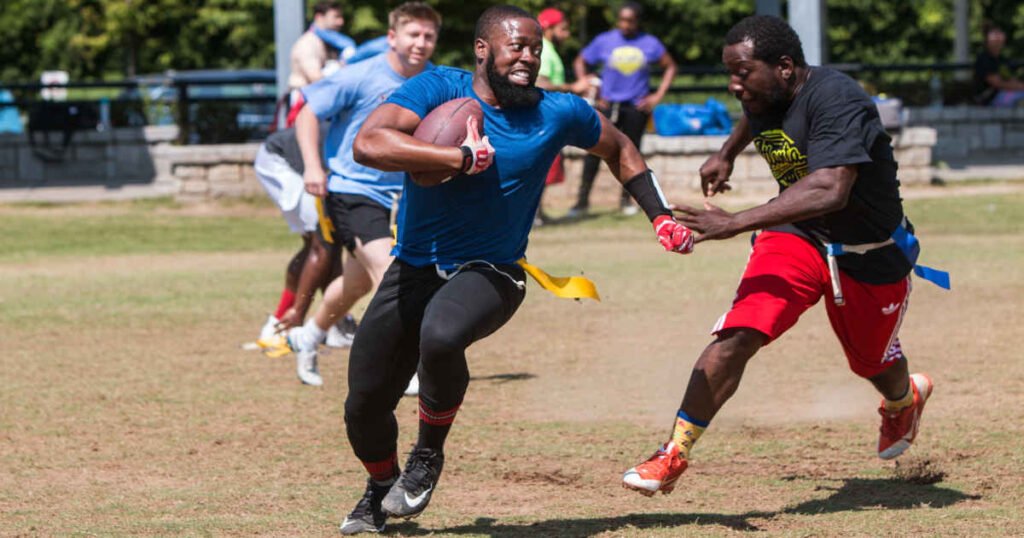The majority of sports fans worldwide are familiar with American football. It is known as a game filled with excitement and intense physical contact. But what if we told you that there’s a version that is equally fun, safer, and requires no physical contact? That game is Flag football, a sport that sets no limits in terms of your age, skill, or your fitness levels. Anyone can learn how to play it, and we will help you to master it by providing you with the flag football rules and basics.
Flag Football 101
Flag football is played between two teams of 5-8 players. Players carry the ball throughout the field, scoring the point when passing the goal line. You will win the match if you score more points than your opponent.
The flag football field is a rectangle, 70 yards long and 30 yards wide. The end zone, which comes after the goal line, is 10 yards wide.
There’s no need for fancy equipment since players only need flags and a football. One match lasts 40 minutes and starts with a coin toss. After half-time, both teams switch sides.
Basic Flag Football Rules
- The player cannot guard their flag.
- The carrier may pass the ball backward and use legal pitches behind the line of scrimmage.
- Beyond the line of scrimmage, players must pass the ball forward. Pitches from this point are not permitted, only direct handoffs.
- The “seven-second passing clock” – The quarterback must pass the ball in seven seconds.
- Offense players must steer clear and cannot get in the rusher’s way.
- The defense player off the line of scrimmage by seven yards may rush.
- The ball is dead and not in the play when:
- The point is scored,
- The ball touches the ground,
- The carrier’s body (besides their hands or feet)touches the ground,
- The carrier’s flag is pulled from their belt or
- The carrier steps out of bounds.
For more clarity on the rules, keep reading.
Safety Above All Else
Safety is a priority in flag football. There is no physical contact between the players of both teams, and they’re not allowed to do the following maneuvers like in American football:
- Tackling
- Diving
- Fumbling
- Screening
- Blocking
All players wear two flag football flags attached to the sides of their belts. Since there is no physical contact between the players, you “tackle” the ball carriers by pulling one or two flags from their belts.
Scoring
The team starts the match on their 5-yard line, and both teams have four downs to get across the midfield. When they successfully do that, they will have three downs to get a touchdown. To clarify, a “down” is a play in NFL flag football.
By getting a touchdown, you’ll get six points on the scoreboard. Flag football players also have the chance to gain an extra point or two by way of conversion. A team can get one point from the five-yard line, and from the 10-yard line, they will get two points. Safety earns you two points.
Passing
According to flag football rules, every pass has to go ahead, and players must receive those passes behind the scrimmage line. This rule also applies to shovels or short passes.
The quarterback must throw the ball in 7 seconds. Otherwise, the play will be dead. Other players can’t rush him, and the QB is forbidden from running the football.
Receiving
All players can receive the football. This unique rule allows the coaches to implement a wide range of flag football strategies and teach players to improve their offense.
Remember that one foot must be in bounds when you make a catch while playing flag football.
Defense
As a no-contact sport, players must learn to pull the flag or flags from the attacking player’s belt. The basic idea is to be in front of the attacking player all the time and quickly pull the flag from the top part of their belt.
Most teams use a defense strategy where you guard one player, but some teams will use a zone defense, where a player puts their focus on defending one part of the playing field.
Penalties
Even though there is no contact in flag football, players can make fouls, for which they will receive penalties. There is an extensive list of more than 20 penalties, and we will explain the most common ones players get.
One of them is flag guarding. To clarify, this happens when you either defend the flags on your belt or if you smack your opponent’s hand. You’ll get penalties for losing yards and getting an automatic first down if you hold your opponent or interfere with a pass.
Useful Tips and Tricks
In flag football, a good offense is crucial to winning games. Try implementing a well-balanced offense where some players can run the ball, and others can make good passes. Working on communication is also vital because it can help make moves faster and pull off impressive flag football plays.
Defense is just as important as offense. You should hone your flag-pulling skills and create a strategy for executing efficient flag football defensive plays.
Conclusion
Flag football is an equally entertaining and fun-packed alternative to American football. It relies on inclusivity, safety, and fair play.
We’ve provided you with all the essential flag football information so you can start playing it immediately.
Ready your flags and start playing!
- The 1958 NFL Championship and “The Greatest Game Ever Played” – TBT #24 - May 15, 2025
- Youngster Pele’s World Cup Final Performance Leaves Everyone in Awe – TBT #23 - November 14, 2024
- Ranking the Top 10 Worst NBA Trades Ever – Biggest Regrets That NBA Teams Made - November 13, 2024
